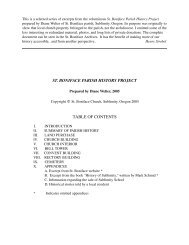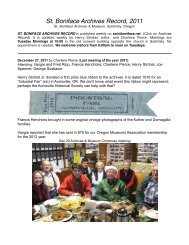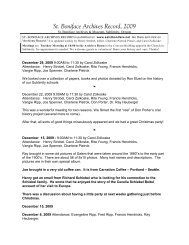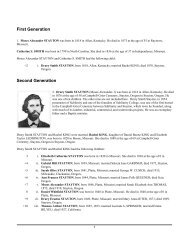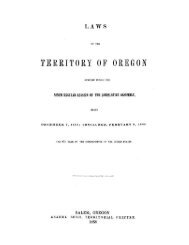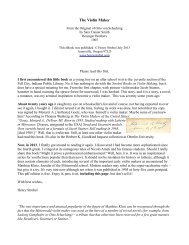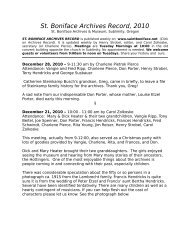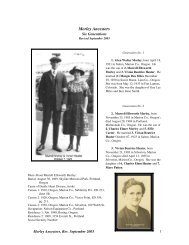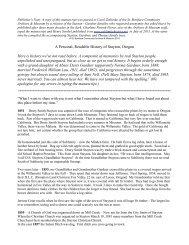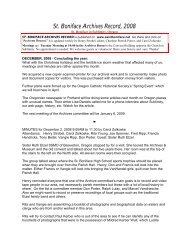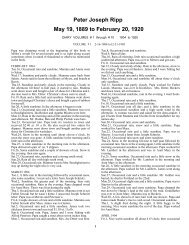The Catholic Church at St. Paul, Oregon - Henry Strobel
The Catholic Church at St. Paul, Oregon - Henry Strobel
The Catholic Church at St. Paul, Oregon - Henry Strobel
You also want an ePaper? Increase the reach of your titles
YUMPU automatically turns print PDFs into web optimized ePapers that Google loves.
<strong>The</strong> <strong>C<strong>at</strong>holic</strong> <strong>Church</strong> <strong>at</strong> <strong>St</strong>. <strong>Paul</strong>, <strong>Oregon</strong>Etienne Lucier, a French Canadian and former member of the William Price Hunt Overland Expedition, came to<strong>Oregon</strong> in 1812. He l<strong>at</strong>er worked for the Hudson's Bay Company. He moved to the Willamette Valley (two and ahalf miles west of present day Champoeg) in 1829. He was soon followed by Joseph Gervais and Louis Labonte.This growing settlement of former Astor-Hunt and Hudson's Bay Company employees came to be known asFrench Prairie.On July 3, 1834, the French Canadian <strong>C<strong>at</strong>holic</strong>s living <strong>at</strong> French Prairie sent a letter to Bishop Joseph NorbertProvencher, vicar general and auxiliary bishop to the Bishop of Quebec, <strong>at</strong> Red River (now the Archdiocese ofSaint Boniface, Manitoba) <strong>at</strong> the suggestion and with the help of Dr. John McLoughlin, chief factor of theHudson's Bay Company <strong>at</strong> Fort Vancouver (now Vancouver, Washington), asking for a priest to serve theirneeds. Receiving no reply, they sent a second letter on February 23, 1835.On June 6, 1835, Bishop Provencher wrote Dr. John McLoughlin th<strong>at</strong> he had no priests to spare but th<strong>at</strong> hewould soon travel to both Canada and Europe to see if he could obtain some priests for the <strong>Oregon</strong> Country. Healso wrote a letter on June 8, 1835, to the "families of the Willamette Valley and beyond the Rockies" th<strong>at</strong> hewould send someone to "bring the word of God to them" and the Indian tribes. This became the first pastoralletter in the <strong>Oregon</strong> Country. On February 28, 1836, <strong>at</strong> Bishop Provencher's request, the Holy See granted anindult annexing the <strong>Oregon</strong> Country to the Vicari<strong>at</strong>e Apostolic of Red River. Bishop Provencher also wroteBishop Joseph Signay of Quebec for priests.Buoyed by the promise th<strong>at</strong> a priest would soon be sent, the <strong>C<strong>at</strong>holic</strong> Canadians constructed a log church in1836, the first <strong>C<strong>at</strong>holic</strong> church in <strong>Oregon</strong>, four miles from Champoeg. Dr. McLoughlin, finding it not properlyloc<strong>at</strong>ed, had it dismantled, log by log, and moved to Saint <strong>Paul</strong> and rebuilt. It was thirty by seventy feet and hada small room in back of the altar for the priest's residence. Upon reception of the news th<strong>at</strong> the Hudson's BayCompany would provide passage to the <strong>Oregon</strong> Country for two priests, Bishop Signay of Quebec, on April 17,1838, appointed Fr. Francis Norbert Blanchet vicar general of Quebec with jurisdiction over the <strong>Oregon</strong>Country. He also appointed Fr. Modeste Demers assistant to Fr. Blanchet.Fr. Francis Blanchet joined the Hudson's Bay Company bo<strong>at</strong> brigade on May 5, 1838, after it had departed fromLachine near Montreal two days before. He arrived <strong>at</strong> Red River on June 5 where he met Bishop Provencher andDr. John McLoughlin (who was on his way to Montreal and London). Fr. Modeste Demers joined Fr. Blanchet<strong>at</strong> Red River and they departed for Fort Vancouver on July 10. <strong>The</strong>y arrived <strong>at</strong> Fort Vancouver on November 24,1838, delayed several days by a bo<strong>at</strong> mishap <strong>at</strong> the Dalles of the Dead on the Columbia River (in BritishColumbia) in which twelve people drowned.James Douglas, chief factor in the absence of Dr. McLoughlin, and three represent<strong>at</strong>ives of the Canadians of theWillamette Valley, Joseph Gervais, <strong>St</strong>ephen Lucier and Pierre Beleque met the two priests <strong>at</strong> Fort Vancouver onbehalf of the French Prairie settlers who had to return home because of the l<strong>at</strong>e arrival of the priests <strong>at</strong> FortVancouver.On January 3, 1839, Fr. Francis Blanchet left Fort Vancouver with Etienne Lucier and Pierre Beleque in twolarge canoes taking portage around "Wallamette Fall" on January 4, arriving <strong>at</strong> "Campement de Sable"(Champoeg) on January 5. <strong>The</strong> men travelled on horseback the last four miles to the log church.On January 6, 1839, Fr. Francis Norbert Blanchet offered the first Mass in wh<strong>at</strong> is now the <strong>St</strong><strong>at</strong>e of <strong>Oregon</strong>. Itwas the Feast of the Epiphany. He blessed the log church under the p<strong>at</strong>ronage of Saint <strong>Paul</strong> the Apostle. <strong>The</strong>Mass was <strong>at</strong>tended by the Canadian <strong>C<strong>at</strong>holic</strong>s, many of whom had taken Indian wives, and their families. Fr.Blanche! recorded 24 marriages and 74 baptisms. He concluded the mission on February 4.During Holy Week beginning on March 17, 1839, F<strong>at</strong>her Blanchet devised the <strong>C<strong>at</strong>holic</strong> Ladder <strong>at</strong> the Cowlitzmission (near Toledo, Washington) while teaching the Indians from various tribes. He devised a square stickwith 40 marks representing the 40 centuries before Christ, 33 points followed by a cross representing Our Lord'sMe, 18 marks and 39 points representing the years th<strong>at</strong> followed, giving F<strong>at</strong>her Blanchet the opportunity to
explain the history of salv<strong>at</strong>ion. L<strong>at</strong>er, mis inform<strong>at</strong>ion was transferred to a pictorial chart.F<strong>at</strong>her Blanchet returned to <strong>St</strong>. <strong>Paul</strong> in May along with F<strong>at</strong>her Demers. Fr. Demers had to return to FortVancouver because of a bad cold. Fr. Blanchet again conducted a thirty-day mission, this time using the <strong>C<strong>at</strong>holic</strong>Ladder very effectively since many neophytes could not understand French th<strong>at</strong> well. It was exposed on Sundaysand used to give instruction to the congreg<strong>at</strong>ion. During his visit, Fr. Blanchet blessed the ground for a cemetery<strong>at</strong> <strong>St</strong>. <strong>Paul</strong>. This became the first <strong>C<strong>at</strong>holic</strong> cemetery in the Pacific Northwest.In October 1839, Governor James Douglas informed F<strong>at</strong>her Blanchet th<strong>at</strong> the Hudson's Bay Company hadremoved its restrictions on the establishment of a permanent <strong>C<strong>at</strong>holic</strong> mission south of the Columbia. F<strong>at</strong>herBlanchet took up permanent residence <strong>at</strong> <strong>St</strong>. <strong>Paul</strong> on October 12, 1839, thus making <strong>St</strong>. <strong>Paul</strong> the first <strong>C<strong>at</strong>holic</strong>parish in the <strong>St</strong><strong>at</strong>e of <strong>Oregon</strong>. Dr. John McLoughlin had a lot to do with the Hudson's Bay Company's change ofheart in London. He visited <strong>St</strong>. <strong>Paul</strong> shortly after Fr. Blanchet's arrival.<strong>The</strong> second meeting for the establishment of a Provisional Government for <strong>Oregon</strong> was held on June 1, 1841, <strong>at</strong>the Saint <strong>Paul</strong> Meeting Hall. F<strong>at</strong>her Francis N. Blanchet was chairman of the committee charged with drawingup a code of laws for the Provisional Government.On June 8, 1842, F<strong>at</strong>hers Francis Norbert Blanchet, Modeste Demers and Pierre DeSmet SJ met <strong>at</strong> FortVancouver to discuss the work of the missions, the establishment of an ecclesiastical organiz<strong>at</strong>ion in the <strong>Oregon</strong>Country and the sending of Fr. DeSmet to Europe for reinforcements and supplies.<strong>St</strong>. Joseph's College was established <strong>at</strong> <strong>St</strong>. <strong>Paul</strong>, opening on October 17, 1843, the first <strong>C<strong>at</strong>holic</strong> boys' school inthe Pacific Northwest. Thirty boys registered for the opening day. It closed in June 1849, then served briefly as ahospital during a typhoid epidemic before falling into decay. F<strong>at</strong>her Langlois was placed in charge.Pope Gregory XVI established the <strong>Oregon</strong> Country as a vicari<strong>at</strong>e apostolic (church mission territory with abishop when there is no established hierarchical structure) on December 1, 1843, naming F<strong>at</strong>her Blanchet asvicar apostolic. News of this did not reach <strong>Oregon</strong> until November 4, 1844.On August 17, 1844, Fr. DeSmet arrived <strong>at</strong> <strong>St</strong>. <strong>Paul</strong> accompanied by Fr. Blanchet, several <strong>St</strong>. <strong>Paul</strong> parishionersand the "reinforcements" from Europe: four Jesuit priests, some lay brothers and six Sisters of Notre Dame deNamur, the first Sisters to serve in the <strong>Oregon</strong> Country. Fr. DeSmet established the first Jesuit mission in <strong>Oregon</strong>which he dedic<strong>at</strong>ed to <strong>St</strong>. Francis Xavier as a motherhouse and noviti<strong>at</strong>e. It was loc<strong>at</strong>ed not far from <strong>St</strong>. <strong>Paul</strong> ona bluff overlooking <strong>St</strong>. Ign<strong>at</strong>ius Lake (now Connor's Lake).<strong>The</strong> Sisters of Notre Dame de Namur opened the first academy for girls in <strong>Oregon</strong> on September 9, 1844,although construction of the new building was not completed until October. It was called "Sainte Marie deWallamette."Fr. Louis Vercruysse SJ established a church <strong>at</strong> <strong>St</strong>. Louis on the Grand Prairie for <strong>C<strong>at</strong>holic</strong> Canadians livingthere in October, 1844. <strong>The</strong> log church was built there in the summer of the following year.F<strong>at</strong>her Francis Norbert Blanche! was consecr<strong>at</strong>ed bishop in <strong>St</strong>. James C<strong>at</strong>hedral, Montreal, by Bishop Ign<strong>at</strong>iusBourget on July 25, 1845, for the Vicari<strong>at</strong>e Apostolic of the <strong>Oregon</strong> Country. Bishop Blanchet left Montreal forEurope on August 12, arriving in Paris on September 8 to begin his work of obtaining funds, supplies andreinforcements for the <strong>Oregon</strong> Country and to petition Rome, on his own initi<strong>at</strong>ive, for the establishment of anecclesiastical province in the <strong>Oregon</strong> Country. He was more than successful. Pope Gregory XVI, on July 24,1846, issued a papal brief establishing the ecclesiastical province of <strong>Oregon</strong> City with three Sees of <strong>Oregon</strong> City,Walla Walla and Vancouver Island, British Columbia. Bishop Francis Norbert Blanchet was named Archbishopof <strong>Oregon</strong> City. <strong>The</strong> Archdiocese of <strong>Oregon</strong> City became the second oldest archdiocese in the United <strong>St</strong><strong>at</strong>essince the United <strong>St</strong><strong>at</strong>es and Gre<strong>at</strong> Britain had just settled their boundary disputes hi the Pacific Northwest theprevious month. A new brick church, the first in <strong>Oregon</strong>, was built in Saint <strong>Paul</strong> using sixty thousand bricks
fired on the church site. It was dedic<strong>at</strong>ed on November 1, 1846.Archbishop Blanchet arrived in <strong>Oregon</strong> on August 19, 1847, bringing with him seven more Sisters of NotreDame de Namur, six Jesuits, five diocesan priests and one seminarian. Archbishop Blanchet ordained FT. J. F.Jayol to the priesthood on September 19, 1847, <strong>at</strong> <strong>St</strong>. <strong>Paul</strong>, the first ordin<strong>at</strong>ion in <strong>Oregon</strong>. On October 31,Archbishop Blanchet ordained Fr. B. Delorme, future vicar general of the <strong>Oregon</strong> City Archdiocese, to thepriesthood <strong>at</strong> Saint <strong>Paul</strong>. On the feast of Saint Andrew, November 30, 1847, Archbishop F. N. Blanchetconsecr<strong>at</strong>ed Fr. Modeste Demers Bishop of Vancouver Island <strong>at</strong> Saint <strong>Paul</strong>. News of the Whitman Massacre hadnot yet reached <strong>St</strong>. <strong>Paul</strong>.Archbishop Blanchet opened the First Provincial Council of <strong>Oregon</strong> in his archiepiscopal residence <strong>at</strong> Saint <strong>Paul</strong>on February 28, 1848. It was <strong>at</strong>tended by Bishops Demers and A. M. A. Blanchet and most of the clergy andlasted three days. Archbishop Blanchet transferred his archiepiscopal residence to <strong>Oregon</strong> City on December 21,1848.Sr. Renilde, 30, a Sister of Notre Dame de Namur, died <strong>at</strong> Saint <strong>Paul</strong> on April 3, 1849, probably of pneumonia.She was the first Religious to die <strong>at</strong> <strong>St</strong>. <strong>Paul</strong>.On May 19, 1849, a large brigade of <strong>C<strong>at</strong>holic</strong> families of Saint <strong>Paul</strong>, Saint Louis and Vancouver left for theCalifornia gold fields. <strong>The</strong>y contracted a fever upon arrival in California and forty died, half of whom weref<strong>at</strong>hers of families.In March 1852, the Sisters of Notre Dame de Namur were forced to close their school <strong>at</strong> Saint <strong>Paul</strong> because ofdeclining school enrollment due to the California Gold Rush. On December 1, 1852, five Sisters of Providencefrom Montreal arrived in <strong>Oregon</strong> City. <strong>The</strong>y went to Saint <strong>Paul</strong> for two months as guests of the Sisters of NotreDame de Namur. <strong>The</strong>y l<strong>at</strong>er became the pioneer found<strong>at</strong>ion for the Sisters of Charity of Providence in Chile.One of the Sisters, Sr. Bernard Morin, became their Mother General in Chile.Twelve Sisters of the Holy Names of Jesus and Mary arrived in <strong>Oregon</strong> on October 21,1859. On February1,1861, four Sisters of the Holy Names reopened the school <strong>at</strong> Saint <strong>Paul</strong> which had been vac<strong>at</strong>ed in 1853 by theSisters of Notre Dame de Namur.<strong>The</strong> new <strong>C<strong>at</strong>holic</strong> Cemetery was established in 1875. Archbishop Francis N. Blanchet was buried there after hisde<strong>at</strong>h in 1883. A mortuary chapel for the Sisters and Priests, loc<strong>at</strong>ed in the back of the cemetery overlookingMission Creek, was razed in 1939. It was replaced by a fence and a granite monument.Archbishop William H. Gross, CSsR, consecr<strong>at</strong>ed <strong>St</strong>. <strong>Paul</strong> <strong>Church</strong> on May 25, 1898, the first church in thePacific Northwest to be consecr<strong>at</strong>ed.On March 25, 1993, the "Mount Angel Earthquake" seriously damaged the Saint <strong>Paul</strong> church, although the altarsand st<strong>at</strong>ues were not harmed nor did the church collapse considering the five-brick thick walls had no cement ormortar holding them together.When the church was declared unsafe following the earthquake of March 25, 1993, the Parish and theArchdiocese agreed th<strong>at</strong> it would be restored the same as before, due to its historic significance in the PacificNorthwest.<strong>The</strong> walls were completely taken down in sections; only the roof and floor remained. <strong>The</strong> walls were replacedwith concrete blocks reinforced with steel and were faced with the original bricks; the remainder of the brickswere sold and the money used in the reconstruction. Restrooms were added in the northwest corner of thechurch. <strong>The</strong> steeple was highly reinforced and the rooster <strong>at</strong>op regilded. A reconcili<strong>at</strong>ion room was added andthe pews and floor were refinished. <strong>The</strong> stained glass windows were repaired and re-leaded, and a new soundsystem was installed, along with a new altar of sacrifice and lecterns. Recently, the area was landscaped and new
lacktop and sidewalks were added.Sunday Mass was celebr<strong>at</strong>ed from 1993-1995 in the Saint <strong>Paul</strong> Fire Department Hall and weekday Masses werecelebr<strong>at</strong>ed in the former Key Bank in Saint <strong>Paul</strong> owned by a parishioner, Don Davidson. <strong>The</strong> church was rededic<strong>at</strong>edon November 5,1995 after the completion of its restor<strong>at</strong>ion.Without the gre<strong>at</strong> response of the people of Saint <strong>Paul</strong>'s Parish and our many friends in Christ, this enormousfe<strong>at</strong> could not have been accomplished.— Fr. Gregory Moys



